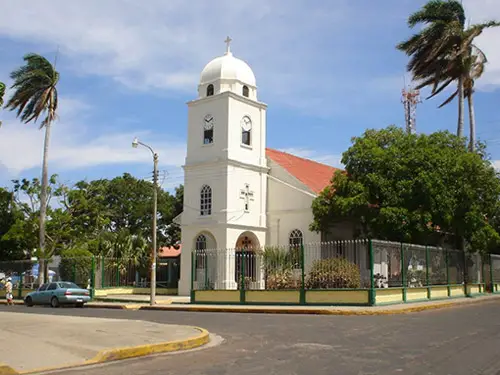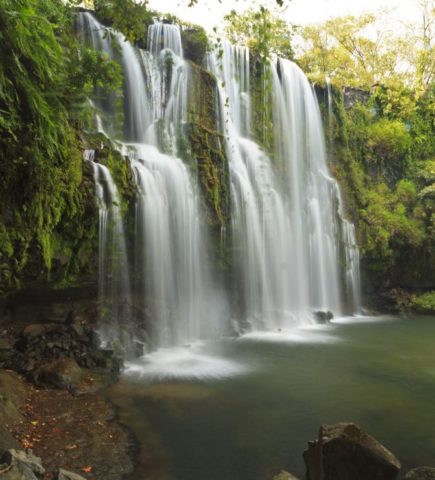
Bagaces is home of the Tempisque Conservation Area (ACT), one of the most active and dedicated conservation organizations in the country. With beautiful landscapes and warm weather all year round it is an ideal place to stop, meet its people and enjoy a refreshing drink on your way to Liberia or to the national parks of this province.
Brief Historical Review.
In pre-Columbian times, the territory that currently corresponds to the Bagaces canton, a group of indigenous people called Nahua or Aztec, had an enclave in the region. Bagaces in the course of its existence as a human settlement has had three locations.
The first in the area near the confluence of the Tenorio and Curubicí rivers (today Corobicí), in the jurisdiction of the current Cañas canton, where a hamlet was established in 1687, to form a colony with the inhabitants of the Bagaces valley, but without achieving a consolidated settlement. The second was located northwest of the first, in the area near the west bank of the river known today as Villa Vieja in 1739. The last was in 1790, carried out by Father Nicolás Carrillo in its definitive location that knows the town of Bagaces.
The catholic parish was erected in 1790, dedicated to the Virgin of the Immaculate Conception. The current church was built in 1940, during the archbishopric of Monsignor Don Víctor Manuel Sanabria Martínez, second Archbishop of Costa Rica; which at the moment was suffragan of the Diocese of Tilarán of the Ecclesiastical Province of Costa Rica.
In the administration of our first Head of State, Mr. Juan Mora Fernández, on November 11, 1824, the town of Concepción de Bagaces was granted the title of the villa. On November 4, 1825, Bagaces constituted a town of the Cañas district, of the Western Department, one of the two into which, once, the territory of the State was divided. On March 27, 1835, the Bagaces village was part of the Department of Guanacaste. By December 7, 1848, Bagaces and Cañas formed the fourth canton of the Guanacaste province. On September 29, 1858, the transfer of the villages of Bagaces and Cañas to the site called Bebedero was arranged, at the confluence of the Las Piedras (today Blanco) and Tenorio rivers; Twenty-four years later, on July 30, 1918, in the government of Don Federico Tinoco Granados, the village reached the category of town.
In the school territorial division of the Republic established in 1886, Bagaces constituted the number one school district of this canton. The school is named after Don Tomás Guardia Gutiérrez. Liceo de Bagaces (high school) began its activities in 1968, in the administration of Mr. José Joaquín Trejos Fernández, at the Rafael Iglesias Castro school facilities. The first public lighting of Bagaces was carbide lanterns placed in 1910. The electric lighting with bulbs was installed in 1960, in the government of Mr. Mario Echandi Jiménez.
The name of the canton is in memory of the Bagatzí chief of the tribe that inhabited the region when the Spaniards arrived in the 16th century. According to Don Carlos Gagini in his work “The Aborigines of Costa Rica”, it is an indigenous word, Baga, probably from Nahuatl, which means reed, cane, and tzi: place; that is Place of cane or reed.
Location.

Located just north of Palo Verde National Park, the town of Bagaces in Guanacaste is the capital of the canton of the same name. It is located about 20 kilometers from the western shore of Lake Arenal and is a perfect example of the type of town that can be found throughout Costa Rica.
The average geographical coordinates of the canton of Bagaces are 10º30’38” north latitude and 85°14’22” west longitude. The maximum width is 57 km., in the north and south direction, from the source of the Salto River to the confluence of the Tempisque and Bebedero rivers. The limits of the canton are the following: to the north with Upala; to the west with Liberia, Carrillo and Santa Cruz; to the east Cañas; and south with Nicoya.
Natural protected area.
Bagaces is known as the home of the Tempisque Conservation Area (ACT), it is responsible for the administrative supervision of the nearby Palo Verde National Park, as well as the Lomas de Barbudal Biological Reserve. The ACT works tirelessly to ensure that the land is maintained and protected and that the thousands of species that inhabit the parks can be enjoyed by future generations.
The locality attracts many tourists who pass through the north of the city, by the volcanoes of Guipilapa and Miravalles, despite these are extinct, many locals claim that they still hear the rumble of the ground under their feet from time to time.

